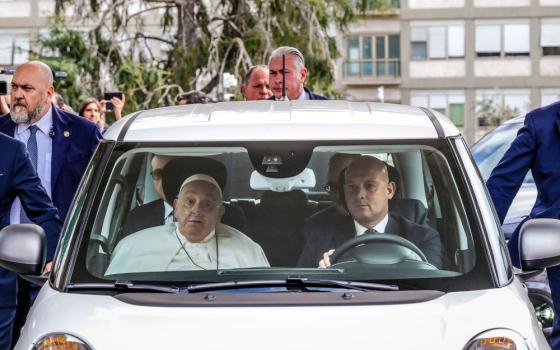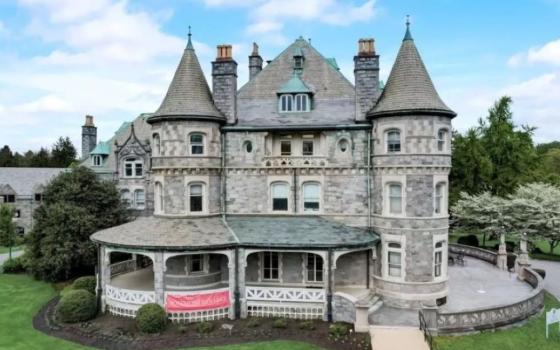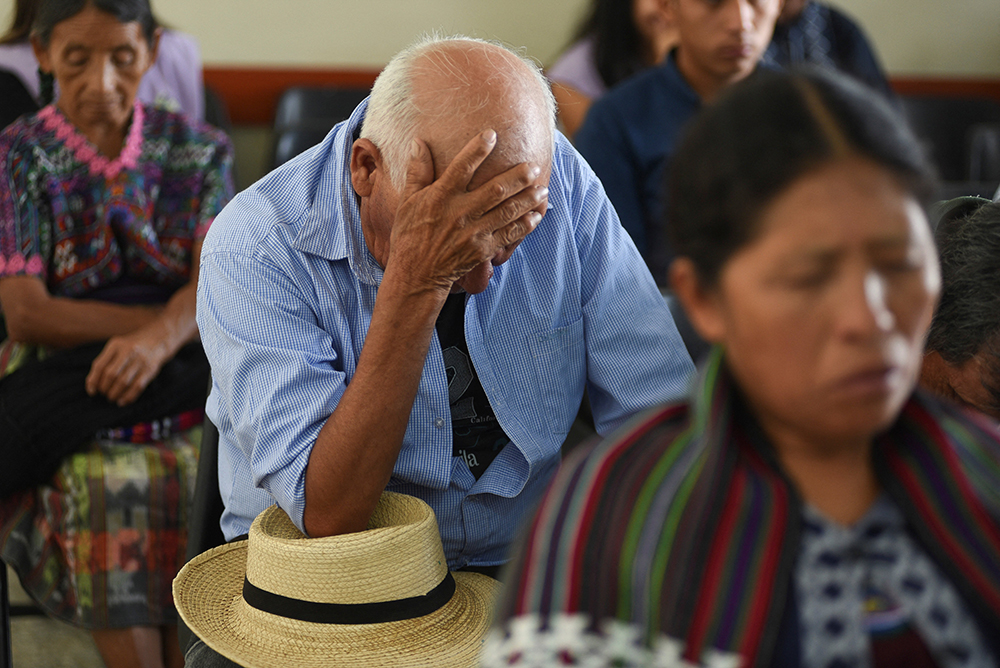
Ixil Indigenous authorities attend a hearing where survivors of the internal armed conflict testify in the Maya Ixil genocide trial at the Supreme Court, in Guatemala City, Guatemala, April 8, 2024. (OSV News/Reuters/Cristina Chiquin)
First, they came for the priests, the catechists, Maya spiritual guides, community leaders. Beginning in the 1970s soldiers arrived in towns and villages in the remote Guatemalan region called the Ixil Triangle with an informant, who typically wore a black hood with holes cut for the eyes. The collaborator, often a local resident, pointed out individuals that soldiers were looking for, and the soldiers killed them.
Details of the terror that gripped the northwest Guatemalan highlands in the 1970s and 1980s are emerging at a major trial now under way in Guatemala City, charging a well-known military leader with responsibility for killing thousands of unarmed civilians. The Archdiocese of Santiago de Guatemala's Human Rights Office and a victims' group, the Association of Justice and Reconciliation, have accused Gen. Benedicto Lucas García, Guatemala army chief of the General Staff between 1978 and 1982, with genocide against the Maya Ixil people. The Human Rights Office's lead lawyer for the case, Mario Trejo Millián, said in an interview that the archdiocese has been involved with survivors for years — family members have long come to the church for help in locating remains of their loved ones.
Advertisement
The military campaign led by Lucas, commonly called Operación Ceniza (Operation Ashes), unfolded during a 36-year civil war (1960-1996) in which some 200,000 died, 93% at the hands of government agents, according to a U.N.-sponsored truth commission. The trial began in April; Human Rights Office director Nery Rodenas told NCR he has "great hope" Lucas will be convicted.
In expert witness testimony, Elizabeth Oglesby, a social geographer who teaches at the University of Arizona and has researched the violence in Guatemala since 1986, called the first phase of the genocide when religious workers and community leaders were eliminated "selective assassination." Among the dead were Sacred Heart priests and six catechists — one of them a 12-year old boy — known as the "Martyrs of Quiche," killed in "hatred of the faith," and beatified on April 23, 2021, in the regional capital, Santa Cruz de Quiche. A host of others, like José Itzep Michicoj, 41, a catechist from the village of Xix, are not formally recognized, but the local faithful call them, too, "martyrs."
Itzep, a father of 10, led the local Rural Worker Catholic Action, belonged to the Ixil Savings and Credit Union Cooperative and a parish Catholic action group. He had achieved a fourth grade education, unusual for a Maya in a region where schools were scarce and children still work alongside their families in the fields.
On a Tuesday morning in February 1981, soldiers went to Itzep's house, tied him up, and demanded to know the whereabouts of his "guerrilla companions" and his weapons (he had none). "When the members of the army didn't receive the answer they wanted, because José … was just a good catechist, they carried out their orders," wrote the authors of a book published by the Guatemalan Conference of Bishops on the lives of some of the religious men and women killed in eight dioceses, Testigos Fieles del Evangelio (Faithful Witnesses of the Gospel, 2009).
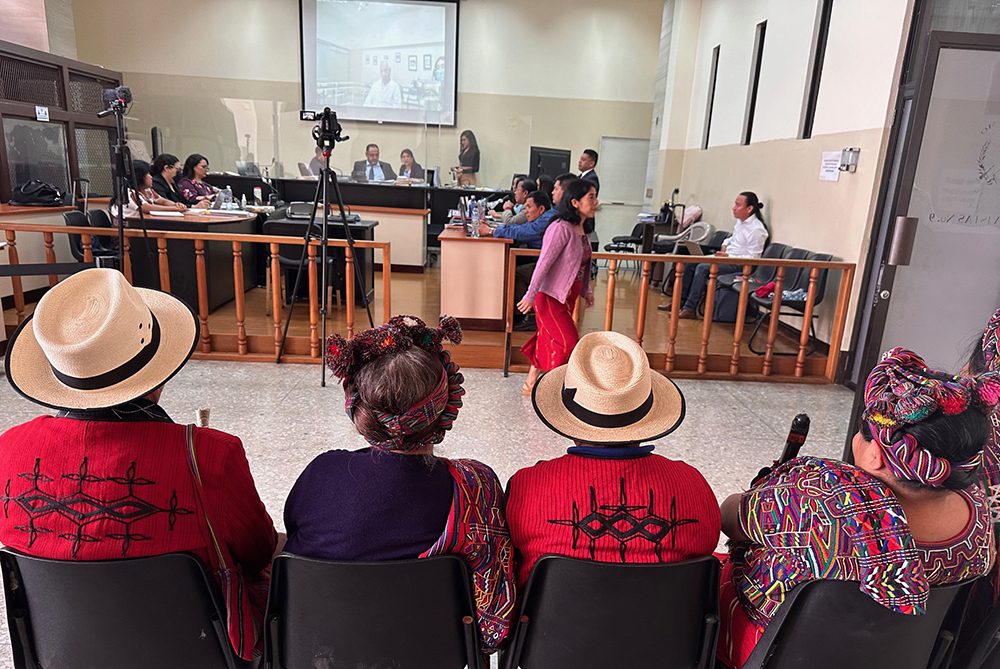
Maya Ixil people attend the hearing against retired Gen. Benedicto Lucas García, on the screen, at a court in Guatemala City. A Guatemalan court began a trial against Lucas, 91, already convicted of crimes against humanity, for the massacre of more than 1,200 Indigenous Ixil Maya people between 1978 and 1982. (Mary Jo McConahay)
Catechists like Itzep accompanied community members as they examined the Gospels, often using liberation theology methods which led to identifying the sinful social structures that kept the poor unhealthy, uneducated, and subject to early deaths. Liberation theology posits that the faithful need not wait until death for liberation and peace, that God does not want his people to suffer but to create his kingdom on earth. Authorities suspected such thinking; the Military Manual Against Subversion, used in training soldiers, considered "groups or individuals acting in attempt to destroy established order" as dangerous to the state. So many religious were being murdered that the bishop in the region, Msgr. Juan Gerardi, made the painful decision to close the diocese after escaping an ambush in 1980.
Benedicto Lucas is Catholic, but the general accused the church of being a "sanctuary" for guerrillas and claimed it helped to recruit people to fight. In a 2019 court proceeding, he branded the Maryknoll order "opprobrious" and said Jesuits fabricated massacres to accuse the army of rights abuse. Lucas denies the massacres. "I was involved in everything, tactical and military, but have no responsibility for innocent spilling of blood," he told me in 1995.
A least 30% of the victims of the conflict registered by the Archdiocesan Project on the Recuperation of Historical Memory belonged to some type of organized social group, and of those more than 50% were religious groups. "This data confirms the great impact that the violence had against community leaders at the beginning of the 1980s," said the report of the church project, whose volunteers interviewed 55,000 people. Gerardi, the head of archdiocese's Human Rights Office and spiritual force behind the historical memory project teams, presented the research findings in a crowded metropolitan cathedral on April 24, 1998. Two days later, an assassin murdered Gerardi with a concrete brick in his driveway as he returned from a family dinner.
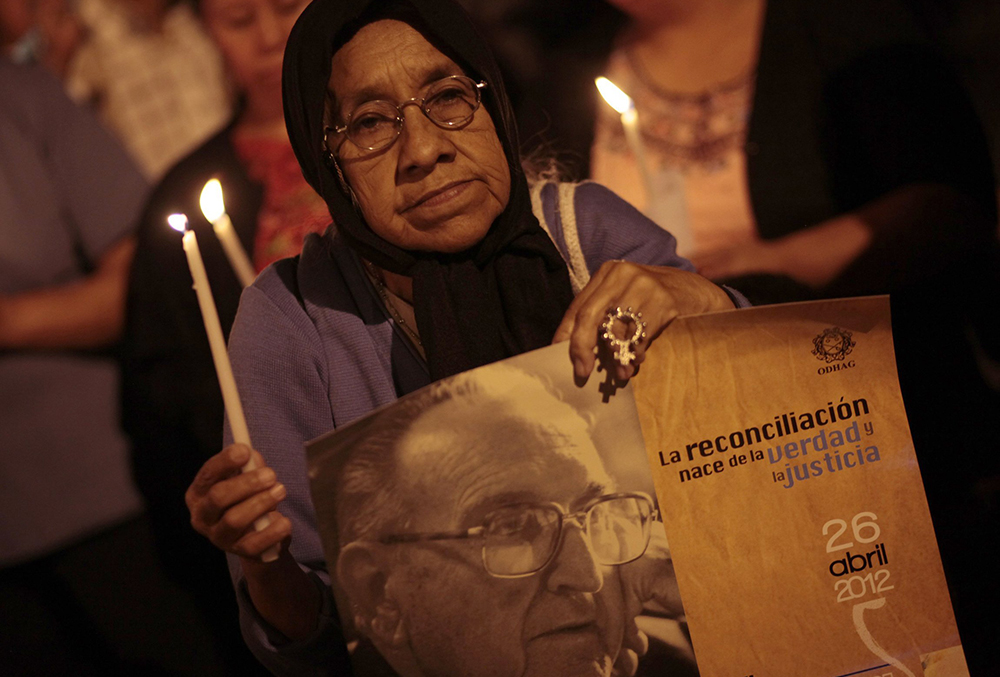
A woman holds a candle and a sign with an image of Auxiliary Bishop Juan Gerardi Conedera outside St. Sebastian Church April 26, 2012, to commemorate the 14th anniversary of his death in Guatemala City. (CNS/Reuters/Jorge Dan Lopez)
Millián, the Human Rights Office's lead lawyer, emphasized that while many religious were murdered, the rural Indigenous are the heart of the genocide case. They were executed for no other reason than that they were Ixil Maya, considered rebellious by the army, labeled an "internal enemy" at a time when the army was fighting guerrillas, and the army suspected the Ixil of supporting them.
The genocide trial began on April 15, with weeks of detailed testimony from Ixil survivors. Dominating the courtroom, looming above the three-judge panel is the ghostly image of the accused projected on a wall serving as a screen — Lucas, fit looking at 91, wearing a bathrobe, attends virtually from the Military Medical Center where he is staying.
After selective assassination and mass killing, Oglesby of the University of Arizona said displacement of survivors who hid in the mountains pursued by soldiers for months or years, or died from starvation and disease, was the third and final phase of the genocide. "It was for them a Calvary," she said.
Psychologist Carlos Paredes, a specialist in Indigenous communities, explained that for survivors, including those whose relatives disappeared in the forced displacement, the anguish never ends. Many affected Maya suffer from what they call susto, a kind of separation of the soul from the body, "like a clock without a battery," Paredes said. Susto can manifest in pain untraceable to physical conditions, nightmares, lack of eating or a silent retreat into oneself, with inability to participate in community life.
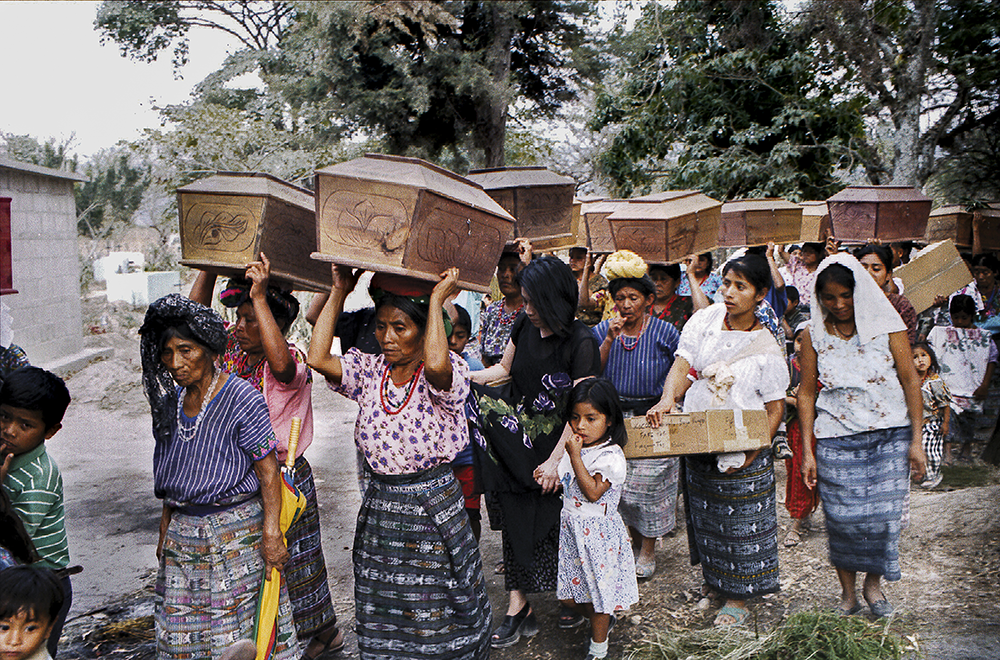
Maya Ixil people carry caskets to bury the remains of loved ones slain during the 36-year long Guatemalan civil war. Since 1996, the Foundation for Forensic Anthropology of Guatemala has taken samples from family members and bones of the deceased, collecting DNA material from 18,000 family members and 10,000 of the dead into the foundation's gene bank. (Berlin Juarez)
Forensic experts have described in a flat, scientific tone how thousands of Ixil were buried clandestinely, often in mass graves, an important part of the record. Remains of a pregnant woman were "in an advanced state of gestation," said a member of the Foundation for Forensic Anthropology of Guatemala. Causes of deaths were "firearm, domestic artifact" (ax, hatchet, machete, knife). Graves in a village where 41 died were "primary burials" — bodies not moved from somewhere else. "Some graves mostly children."
Since DNA became available to investigating teams in 1996 — "a parting of the waters" as another forensic member described it — the scientists have taken samples from family members and bones of the deceased, collecting DNA material from 18,000 family members and 10,000 of the dead into the foundation's gene bank.
Matches have been confirmed, offering a kind of peace to loved ones, who give the dead a Christian burial, often in group funerals where mourners process together from a church to the cemetery. They carry small coffins containing remains; the boxes need only be the length of the body's largest bone, the femur.
The trial is expected to end in July.


